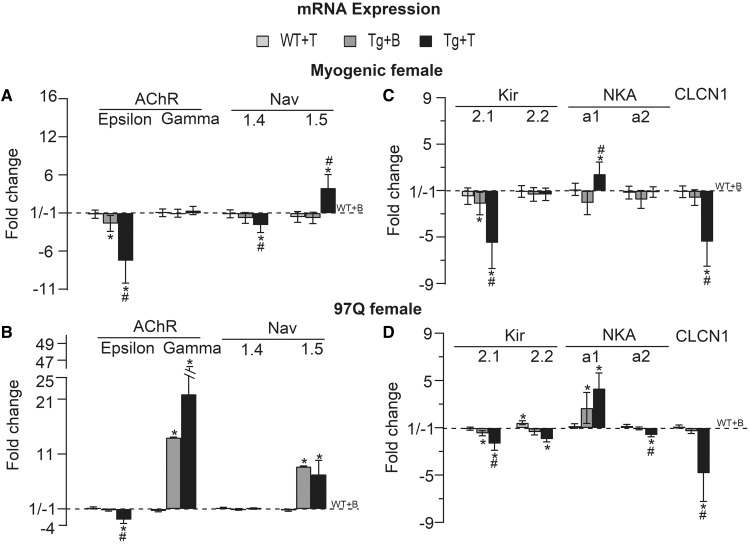Figure 6.
Muscle from acutely diseased females show comparable pathological changes in mRNA expression as chronically diseased males. (A and B) Acute disease in both models is associated with a significant reduction in the amount of mRNA for the adult isoform AChR ε-subunit. A complementary increased expression of the neonatal isoform AChR γ-subunit occurred only in AR97Q females with 2 weeks of treatment, but not in myogenic females, aligning well with prolonged mEPP decay times in diseased AR97Q females but not in diseased myogenic females (Fig. 5I). AChR ε-subunit is also reduced in asymptomatic control females of both models, like for pre-symptomatic AR97Q males (Fig. 3). Because controls females are not exposed to exogenous androgens, the milder but nonetheless significant effects on AChR ε-subunit suggest that the mutant AR may drive pathological expression of some genes in SBMA muscle independent of androgens, with androgens further exacerbating AR’s toxic effects. Only diseased myogenic females show reduced expression of the adult isoform Nav1.4 of the voltage-dependent sodium channel, whereas expression of the immature isoform Nav1.5 is increased significantly by disease in both models. Such changes in mRNA expression for the sodium channel and AChR also occur in chronically diseased males (Fig. 2) (17). These data suggest that the sodium channel and AChR are each early targets of disease. (C and D) As expected, mRNA expression of the inward rectifying potassium channel (Kir), the Cl– ion channel and the NKA pump were affected in both acute models, comparable with chronically diseased males (Fig. 2), and likely underlying the reduced RMP of muscle fibers in each model. Note that Kir2.1 mRNA is significantly down-regulated in both symptomatic and asymptomatic Tg females of both models, but that the magnitude of the change is smaller in asymptomatic control Tg females. These changes correlate well with the magnitude of change in the RMP for symptomatic and asymptomatic myogenic females (Fig. 5B), arguing that changes in Kir2.1 heavily influence the RMP. Kir2.2 is also significantly reduced in acutely diseased AR97Q females and thus, may also contribute to the lowered RMP in this model. Expression of the neonatal isoform of the sodium/potassium pump NKA α1 is up-regulated by disease in both acute models, whereas the adult NKA α2 isoform is significantly reduced only in acutely diseased AR97Q females. Clcn1 mRNA expression is significantly reduced in both acute models, paralleling the effects of disease on Clcn1 expression in chronically diseased males (Fig. 2). These data provide further evidence that disease affects specific aspects of synaptic and muscle function, and that these disease events occur early but with a distinct time line of progression, with some representing pre-clinical aspects of the disease. Values are mean fold changes ± SEMs normalized to control WTs (WT + B) based on N/group. Myogenic group: WT + B, WT + T, Tg + B and Tg + T: N = 6. AR97Q group: WT + B and WT + T: N = 5; Tg + B and Tg + T: N = 4. *P < 0.05 from WT +B or WT + T; #P < 0.05 from Tg + B. ‘B’ denotes Blank -treated; ‘T’ Testosterone-treated.

